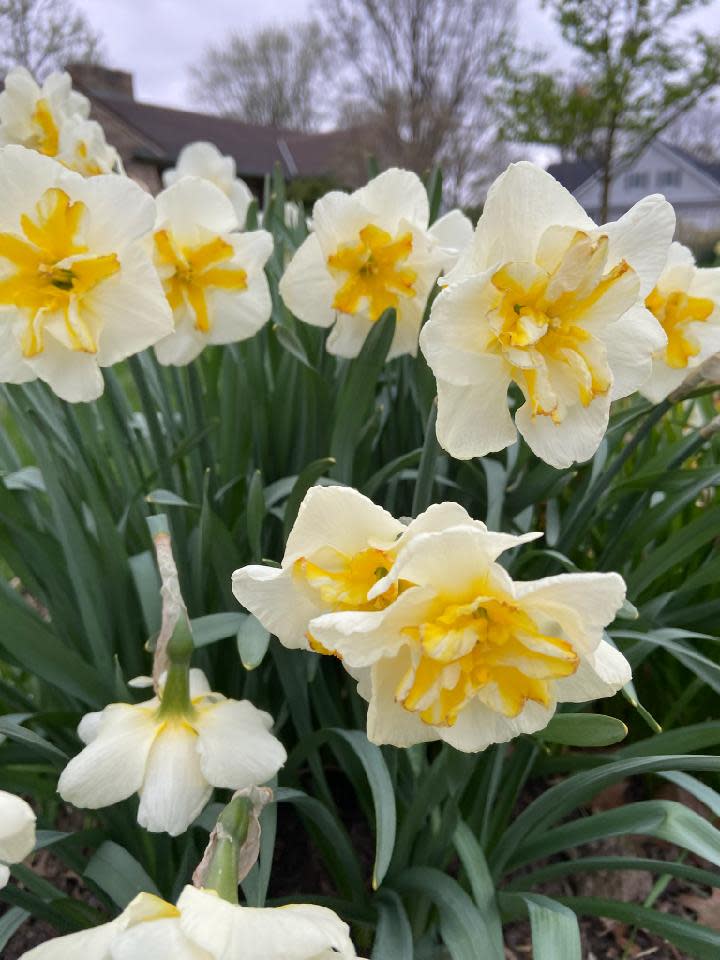Over the Garden Fence: Spring's yard offerings
While it was warm, yard work consisted of digging, separating and potting perennials that were trying to edge out other plants. There was some edging to be done — okay, lots of that. There were some emerging clumps of tulips not yet located by the resident deer population. Lengths of black netting were pulled over to discourage nibbling out the buds.
It was difficult watching the heat bring on parades of daffodils earlier than wanted, but it made Easter pleasant. There are still daffodils coming along and they were bobbing and dancing in the wind yesterday, happy to be engulfed with crispy air. Though hard to photograph, some pictures were managed.

"Lemon Beauty" in the front yard is significant because of the split corona or cup. It is referred to as a butterfly narcissus or a papillon (Fr. for butterfly) variety. The upward-facing flowers are held by 17-inch stems. White petals really show off the sunburst split cup form as the yellow emanates from the center of each cup. Six narrow petals lie against the perianth. In mid to late spring these easy-to-grow daffodils do not tempt deer. The look of whirling pinwheels gives it a whimsical appearance. Yet the blooms have an elegance — not only award-winning but flamboyant.
There are happy, short-stemmed yellow primroses which were hidden under leaf cover most of last week. The poppy foliage is abundant and promising. The three colors of monarda are maniacal and menacing. They are now in several pots for sharing. Of course, these pollinator supporters will go back into my beds. Once established they multiply on runner root systems. This calls for thinning every two or three years. It does not take long to get behind.
Shasta daisy roots were intertwined so a few clumps are ripped up and divided. As the star magnolia and southern magnolias fade, a "Snow Day Surprise" shrub will soon erupt in a flurry of white; it does resemble a short snowstorm.
There is more to share. The bluebirds have drawn my attention. Very early they appeared. In fact, the male was scouting in February. He checked out the box. When sparrows began to drop by, I fastened the clump of spiraling curly glitter tie to the top of the post. Once that was in place, sparrows ceased visitation. A few times a week chopped fruit was offered to the blues because the pair was around daily. A behavior noticed for the first time involved the male bluebird landing near the top of a suet log. He was feeding from there then going up to a magnolia tree branch. After a few nibbles the female would come. Never before had this happened.
The week before Easter I peeked in the box finding a perfect cup-shaped nest with three blue eggs. It is still a thrill to a bluebirder. On Easter morning the male and female brought drama to the "home sweet home" as they were — in turn — dive-bombing a sparrow. This defensive behavior was another new event for me. They were coming right to the ground one time after another hitting the bird. This was awesome proof of their commitment. Two days later there were five eggs.
There's so much promise in spring. Life is good.
Mary Lee Minor is a member of the Earth, Wind and Flowers Garden Club, an accredited master gardener, a flower show judge for the Ohio Association of Garden Clubs and a former sixth grade teacher.
This article originally appeared on Bucyrus Telegraph-Forum: Springtime yard work, daffodils, and bird watching

